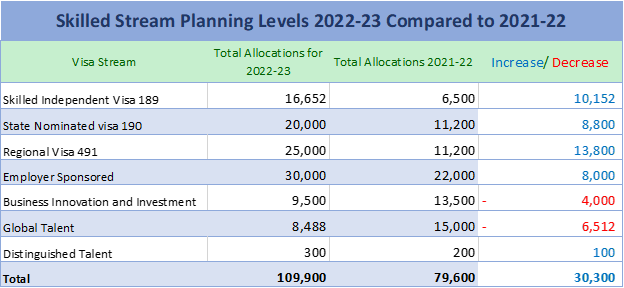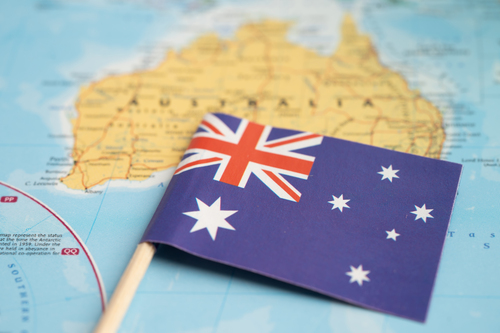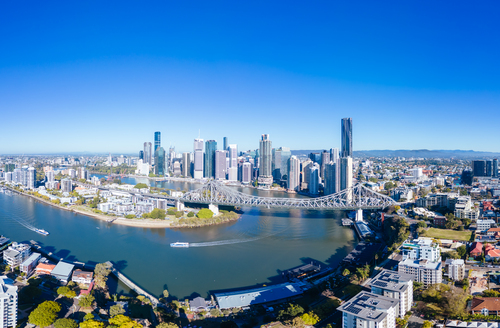Migration planning levels 2022-23 – a clear focus on Skilled Migration with 30, 000 more allocations and less than 30,000 for Family and partner visas.
This shows the significant impact of covid-19 to the labor shortages of Australia now the government is trying to attract more skilled migrants, driving innovation and investment as part of the 2022-23 budget.
The 2022-23 permanent Migration Program ceiling will be capped at 160,000 places.
Migration – Skill stream

The Morrison Government’s Migration Program will focus on skilled migration, with a return to a pre-pandemic composition of roughly two-thirds/one-third across the Skill and Family streams.
The Skill stream will increase to 109,900, more than 30,000 places above 2021-22 planning levels.
There have been significant growth in number of quotas for each stream in Skilled Migration such as:
Employer Sponsored Visa: 8,000 more allocations
Skilled Independent 189 Visa: roughly 10,000 more allocations for the new program years 2022-2023. This is published to deal with the current huge backlog in the Department of Home Affairs
Skilled nominated Visa 190: 8,800 more allocations
Skilled Regional visa 491 or visa 494 will more than double to 25,000 places to support growth in regional Australia.
Business Innovation and Investment (9,500 places), Global Talent (8,448 places) and Distinguished Talent (300 places) are experiencing a modest reduction in the allocations.
This may not be as bad as it sounds for Business Innovation and Investment Visa, because the processing of those business visas have been slow and may not have reached allocations.
The drop in Global Talent visa allocations looks dramatic, but it is useful to remember, that in 2021, while there was an allocation of 15,000, just over 9000 was granted.
Australia is still proven to be the most favorable destination in the world for highly skilled workers and investors.
Occupation lists will be reviewed and updated in early 2022-23 to reflect changes in Australia’s labor market, based on advice from the National Skills Commission.
Migration – Family stream

As part of the Government’s migration program, the Family stream will provide an estimated 50,000 places to support family reunion.
The Partner and Child visa categories are estimated to deliver 40,500 and 3,000 visas respectively (delivery of Partner and Child visas will be subject to demand and visa processing requirements); while 6,000 places will be available for Parent visas; and 500 places for Other Family visas.
This sounds bad, but the Partner visa allocation was nearly doubled during the covid pandemic.
From 2022-23, Partner visa processing will move to a demand driven model.
Granting Partner visas on a demand-driven basis will provide the flexibility to meet the demand for Partner visas in a given program year, and assist in mitigating future growth in the Partner visa pipeline while maintaining immigration integrity.
Working Holiday Makers
There is an increase in the cap for Working Holiday Maker – the 462 visa
11,000 additional WHM visas will be available for prospective backpackers.
This is reasonable when Australia is pushing their programs which support significantly on labor shortages in critical sectors such as the Agriculture Visa program, Working Holiday Makers.
Humanitarian Visas
The 2022-23 Humanitarian Program will be maintained at the current ceiling of 13,750 places
an additional 16,500 places will be available for Afghan nationals under the Humanitarian program and will be equally allocated over the next four years.
There will be 4000 places available for Ukrainians under the Temporary Humanitarian visa. Minister Hawke has commented that Ukrainians will be considered displaced persons that may return to their homeland in the future. They will have access to Medicare and work rights.
Funding the Immigration Department
The budget has released decreased funding for the Department of Home affairs Immigraiton services over the next five years. Funding will go down each year.
2021-22: $3,917m
2022-23: $3,335m
By 2024-25: $2,848m
So how achievable are the targets, with cutting the Department.
Looking at the breakdown of the expenditure can is quite revealing:
Australia spends twice as much, over 2 billion a year, on the management of unlawful non-citizens. While it spends less than a billion, 822 million, on managing the entire skilled and immigration program.
So, the obvious way to improve the budget on Immigration is to spend less on detention and then you have more for visa services and Citizenship.
The best way to do this, is to give those in detention, that can safely be released, Bridging visa and work rights. This will save millions and possibly billions.
Greater funding for the skilled part of the Immigration budget could boost Australia’s post covid recovery and help with skills shortages.








